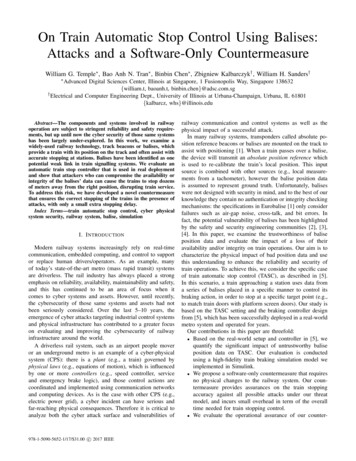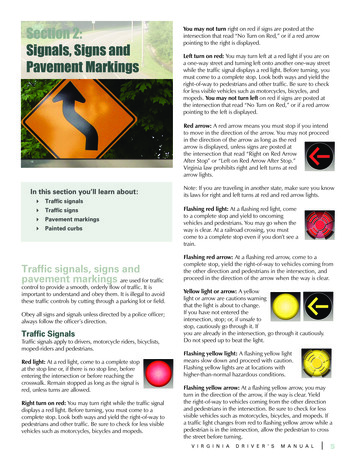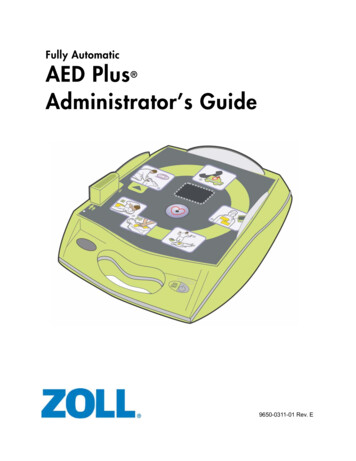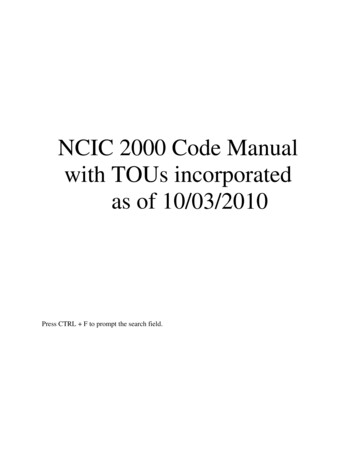
Transcription
On Train Automatic Stop Control Using Balises:Attacks and a Software-Only CountermeasureWilliam G. Temple , Bao Anh N. Tran , Binbin Chen , Zbigniew Kalbarczyk† , William H. Sanders† AdvancedDigital Sciences Center, Illinois at Singapore, 1 Fusionopolis Way, Singapore 138632{william.t, baoanh.t, binbin.chen}@adsc.com.sg† Electrical and Computer Engineering Dept., University of Illinois at Urbana-Champaign, Urbana, IL 61801{kalbarcz, whs}@illinois.eduAbstract—The components and systems involved in railwayoperation are subject to stringent reliability and safety requirements, but up until now the cyber security of those same systemshas been largely under-explored. In this work, we examine awidely-used railway technology, track beacons or balises, whichprovide a train with its position on the track and often assist withaccurate stopping at stations. Balises have been identified as onepotential weak link in train signalling systems. We evaluate anautomatic train stop controller that is used in real deploymentand show that attackers who can compromise the availability orintegrity of the balises’ data can cause the trains to stop dozensof meters away from the right position, disrupting train service.To address this risk, we have developed a novel countermeasurethat ensures the correct stopping of the trains in the presence ofattacks, with only a small extra stopping delay.Index Terms—train automatic stop control, cyber physicalsystem security, railway system, balise, simulationI. I NTRODUCTIONModern railway systems increasingly rely on real-timecommunication, embedded computing, and control to supportor replace human drivers/operators. As an example, manyof today’s state-of-the-art metro (mass rapid transit) systemsare driverless. The rail industry has always placed a strongemphasis on reliability, availability, maintainability and safety,and this has continued to be an area of focus when itcomes to cyber systems and assets. However, until recently,the cybersecurity of those same systems and assets had notbeen seriously considered. Over the last 5–10 years, theemergence of cyber attacks targeting industrial control systemsand physical infrastructure has contributed to a greater focuson evaluating and improving the cybersecurity of railwayinfrastructure around the world.A driverless rail system, such as an airport people moveror an underground metro is an example of a cyber-physicalsystem (CPS): there is a plant (e.g., a train) governed byphysical laws (e.g., equations of motion), which is influencedby one or more controllers (e.g., speed controller, serviceand emergency brake logic), and those control actions arecoordinated and implemented using communication networksand computing devices. As is the case with other CPS (e.g.,electric power grid), a cyber incident can have serious andfar-reaching physical consequences. Therefore it is critical toanalyze both the cyber attack surface and vulnerabilities of978-1-5090-5652-1/17/ 31.00 c 2017 IEEErailway communication and control systems as well as thephysical impact of a successful attack.In many railway systems, transponders called absolute position reference beacons or balises are mounted on the track toassist with positioning [1]. When a train passes over a balise,the device will transmit an absolute position reference whichis used to re-calibrate the train’s local position. This inputsource is combined with other sources (e.g., local measurements from a tachometer), however the balise position datais assumed to represent ground truth. Unfortunately, baliseswere not designed with security in mind, and to the best of ourknowledge they contain no authentication or integrity checkingmechanisms: the specifications in Eurobalise [1] only considerfailures such as air-gap noise, cross-talk, and bit errors. Infact, the potential vulnerability of balises has been highlightedby the safety and security engineering communities [2], [3],[4]. In this paper, we examine the trustworthiness of baliseposition data and evaluate the impact of a loss of theiravailability and/or integrity on train operations. Our aim is tocharacterize the physical impact of bad position data and usethis understanding to enhance the reliability and security oftrain operations. To achieve this, we consider the specific caseof train automatic stop control (TASC), as described in [5].In this scenario, a train approaching a station uses data froma series of balises placed in a specific manner to control itsbraking action, in order to stop at a specific target point (e.g.,to match train doors with platform screen doors). Our study isbased on the TASC setting and the braking controller designfrom [5], which has been successfully deployed in a real-worldmetro system and operated for years.Our contributions in this paper are threefold: Based on the real-world setup and controller in [5], wequantify the significant impact of untrustworthy baliseposition data on TASC. Our evaluation is conductedusing a high-fidelity train braking simulation model weimplemented in Simulink. We propose a software-only countermeasure that requiresno physical changes to the railway system. Our countermeasure provides assurances on the train stoppingaccuracy against all possible attacks under our threatmodel, and incurs small overhead in term of the overalltime needed for train stopping control. We evaluate the operational assurance of our counter-
RadioTachometerBaliseAntennaBalise(a) Train sensors and communication.Vel.B1B2B3B4 B5 B6 Pos.(b) Train stop with position input from 6 balises.Fig. 1. Illustration of train systems and automatic stop control scenario.measure and demonstrate its superior performance. Tounderstand the end-to-end impact on the passengers, wedeveloped a train simulator based on the open-sourceOpen Rails software [6] and incorporated real passengerdata from the Shenzhen Metro [7] into our simulator.The outline of the paper is as follows: Section II presentsthe background on train systems and train automatic stopcontrol, focusing on the role that balises play in helping atrain stop accurately. Section III presents the threat model forattacks that impact the system via balises, while Section IVevaluates the impact of those attacks. Section V then proposescountermeasures to balise attacks, and Section VI evaluatestheir effectiveness. Section VII discusses related work, thelimitations of current study, and future work. Section VIIIconcludes the paper.II. T RAIN AUTOMATIC S TOP C ONTROLLike many other critical infrastructures, trains increasinglyrely on intelligent devices and wireless communication ratherthan mechanical systems and human operators. The criticalsubsystems in a train control system are: automatic train supervision (ATS), automatic train operation (ATO), and automatictrain protection (ATP). ATS works at the upper-most level,handling train scheduling and time tables. ATP works at thelowest level, providing redundancies and emergency brakingcapabilities to prevent train collisions. ATO systems controltrain speed, and can include anything from driver assistancemechanisms to fully autonomous train operation. Railwaybalises, which we discuss in the next section, are a criticalcomponent of both ATO and ATP systems.A. The Role of BalisesRailway balises, also known as absolute position reference(APR) beacons or transponders, are found in railway systemsaround the world. Most commonly found in Europe andAsia, thanks to their inclusion in the European Train ControlSystem (ETCS) [1] and Chinese Train Control System (CTCS)specifications [8], balises are also found in Japanese railwaysystems. There are two types of balises: active (controlled) andpassive (fixed). We focus on passive balises in this work. Apassive balise is a standalone device on the track that receivesa radio frequency signal from a passing train and responds bytransmitting its location. The train then uses this information,along with input from other sources (e.g., tachometer), to recalibrate its location and/or current speed (see Figure 1(a)).In ETCS terminology, this corresponds to Level 2 and Level3 functionality. In contrast, active balises are connected towayside equipment and can transmit local speed limits or evencontrol commands.Traditionally, the position data from balises is regardedas ground truth in train control operations. For example, inthe ETCS the train’s onboard sensors produce an positionestimate that depends on distance travelled [9], [10], and thatestimate is re-calibrated every time the train encounters abalise. The purpose of our work is to critically examine thistrust assumption by applying realistic train control models(Section II-B) and a clearly defined threat model (Section III).B. Train Automatic Stop Control ModelTo analyze the impact of untrustworthy balise position dataon train operations, we apply a model from [5] and introduceadditional logic to implement our threat model. We modela scenario where a train approaching a station controls itsbraking action using balise data to stop at a desired position.The model is based on real systems in use today [5]. It iscommon in many modern train systems to have a set ofplatform screen doors (PSDs) between the station platform andthe train cars to improve commuter safety. In such systems,the coordination between the train doors and PSD systemnecessitates a precise stop.We consider a system with m balises, B {B1 , B2 , . . . , Bm } where balise Bm is the desired stoppoint. This is depicted in Figure 1(b) for a system withsix balises. A stop is considered successful if it is within γ from the last balise. Each balise Bi is represented as atuple Bi bi , si where bi is the physical location ofthe balise and si is its reported location. Obviously in theabsence of failures or malicious tampering si bi for allbalises. Positions are defined relative to the stopping point,i.e. bm 0, and b1 b2 . . . bm . As the train passes overbalise Bi it will adjust its deceleration rate α to compensatefor disturbances as it tries to achieve a full stop at Bm .While there can be many types of disturbances affectinga controller’s performance (e.g., actuator delay, friction,wheel slip), we focus on variations in the characteristicparameters of the train braking system—time delay (Td )and time constant (Tp ). For the control model, we makeuse of the heuristic online learning algorithm (HOA) in [5]which has been successfully applied in an operationalsubway system over several years. Compared to a traditional
temactualaccel.1/S vo1/S xovelocityFig. 2. Block diagram of the stop control model with no countermeasures against balise attacks.proportional/integral/derivative (PID) controller, which is notcontinuously tuned, the learning-based HOA control canbetter handle disturbances.In this model there is a distinction between the expecteddeceleration without disturbances (αie ), the controller deceleration (αic ), and the estimation of the actual deceleration (αir )realized by the train. The expected deceleration as a trainpasses a balise is obtained by applying classical mechanics.Based on an initial velocity vi and a final velocity of 0,the constant deceleration (without disturbances) is given by:v2αie 2sii . Note that this takes a negative value since siis negative with respect to the zero point. The controllerdeceleration is obtained by adjusting αie in response to theobserved train deceleration. Specifically,ceαi 1 αi 1 ηi (αir αic ),(1)where(ηi 1 0.95 ηi1.05 ηiif αir αic 0.05if αir αic 0.05(2)αir is calculated using vi , vi 1 , and the distance betweensuccessive balises Di si si 1 . The acceleration is given2by: αir (vi 1 vi2 )/2Di . The actual train deceleration,trainαi, is influenced by various disturbances and systemimplementation features. We follow [5] and use a train brakingmodel that was empirically determined based on data from anoperating subway system. In the Laplace domain, the actualdeceleration of the train is given by the transfer function:α0αtrain e Td s(3)Tp s 1where Td is the system’s time delay and Tp is the timeconstant. The overall control model, which is implementedin Matlab/Simulink, is illustrated in Figure 2. The intuitionbehind the control process is that the HOA controller adjuststhe braking force each time the train passes over a balise, in amanner similar to that of a driver. The adjustments allow thetrain to smoothly decelerate and stop at the target point in spiteof characteristic lag and random disturbances. In our threatmodel, discussed in the next section, the balises’ data can bealtered. Therefore, the model has been adapted to decouple thetrain’s true position and its perceived position on the tracks.C. System-level SimulationThe train automatic stop control model introduced abovecaptures the behavior of a single train at a single station.While much of our impact analysis (Section IV) focuseson that micro scale and quantifies a train’s performance interms of stopping error (distance) and stopping time underdifferent attack scenarios, a broader system perspective isnecessary to fully understand how potential cyber attacks andcoutermeasures affect rail infrastructure. To this end, we havedeveloped a railway system simulator based on an open-sourcetool that simulates train movement over user-defined maps andtime tables.There are a number of commercial and open-source railwaysimulation tools available online (see [11]). Ultimately, weselected Open Rails [6] because it (i) simulates train movementalong user-constructed tracks and stations; (ii) is built onan engine with time-based simulation and object-orientedprogramming; and (iii) offers a 3D view of trains as well as asupervisory-level view of all train movement. We have addedadditional features to support the integration of passenger flowdata: e.g., passengers’ station and time for tap-in and tap-out,the number of doors on each train, the train capacity, andadding a user-specified dwell time to be added to a train’swaiting time at each station.We refer readers to [11] for further information about ourcustomized train simulator. In short, we have built an enhancedversion of Open Rails and modeled a line in the Shenzhenmetro system to allow system-level modeling of the impact ofattacks to balises. We will discuss selected system-level resultsin Section VI.III. ATTACKS TARGETING BALISESIn a railway system, the key properties to uphold arepassenger safety and operational reliability. In this work wefocus on attacks with an operational impact, targeting thetrack infrastructure (i.e., balises). Previous research in railwaysystem security has indicated that the presence of redundantsystems and fail-safe mechanisms makes safety challengingfor an attacker to compromise, yet those same systems canmake service disruption easier to achieve [3], [12]. Withinthe context of operational reliability, we focus on attackstargeting track infrastructure rather than the rolling stock(trains) themselves for two reasons.First, as a large, physically distributed infrastructure, railwaytrack and wayside systems presents a large physical attacksurface, whereas the rolling stock is typically housed at acentral depot with strict access control. Second, while thereare train onboard systems involved in localization (see Figure 1(a)), targeting the balises maximizes an attacker’s impact
IV. I MPACT OF ATTACKSBefore introducing and assessing countermeasures for baliseavailability and integrity attacks, we use the model in Section II-B to establish the impact of those attacks on the systemas it is. For the results presented in the rest of this paper weconsider a train approaching a station with balises located atAcceleration [m/s 2 -36-16-4 0Position [m](a) Train acceleration with no attacks.Velocity [m/s]since multiple trains passing through a single compromisedtrack section will be affected. Furthermore, this impact may bedifferent for different trains and/or at different times, makingdetection more difficult.We assume the attacker’s goal is to create a service disruption. This is achieved by manipulating balises (e.g., usinga manufacturer’s balise reader/programmer device) to causetrains to have inaccurate stops at the station. By maximizingthe stopping error, the attacker introduces additional dwelltime at stations as the trains correct their alignment with theplatform screen doors (either automatically or with humanintervention). This process, called jogging, can have an adversesystem level effect on train timetables. Within this context, wemake the following assumptions: Fixed Balises: The attacker cannot physically move thebalises, nor introduce additional balises. Only balise dataavailability and integrity may be altered. Trusted Zero Balise: The last balise, Bm , is assumedto be trusted. This balise, at position 0, is often activerather than passive, and it is not used for control inthe HOA algorithm. This last balise interacts with othercomponents (e.g., the platform screen door controllers)which would make tampering easier to detect. We assumethe attacker is unable to make any other passive balisesimpersonate the zero balise. Attacker’s Knowledge and Capability: The attackeris familiar with the technology and operations of therail system, including countermeasures deployed. Specifically, the attacks can be launched by insiders (e.g.,disgruntled employees, malicious contractors) intentionally, or unintentionally (either by mistake, or through amalware-infected balise programming device). In addition, the vast physical attack surface of railway tracksmakes it feasible for an external attacker who understandthe working principal of balises to launch the attack.Since the balises are passive, once the attacker alters theavailability or integrity of one or more balises, those balisesstay in the compromised state. This helps the attacker tocreate a prolonged impact on the system rather than a oneoff incident. Additional assumptions related to our proposedcountermeasures are discussed in Section V. In short, weassume that the trains are provided with prior knowledge aboutwhere balises are located (e.g., expect 6 balises prior to astation, reporting a fixed set of distance values), and we assumea certain accuracy level for the train’s onboard odometry.In this work, we focus on the attack on a single station. Theattacker can have access to one or more balises at one trainstation. For future work the study can be extended to considerattacks over multiple stations.1086420-100-64-36-16-4 0Position [m](b) Train speed with no attacks.Fig. 3. Train acceleration/speed with HOA controller and default parameters.positions [ 100, 64, 36, 16, 4, 0]. The first five balisesare passive, while the final one is active. There are severalfixed and adjustable parameters that characterize the trainstop scenario. We assume an initial position of x 100m(relaxed in Section VI), initial velocity v 10m/s, maximumdeceleration of αmax 1m/s2 , and an allowable stoppingerror of γ 0.3m. In our analysis we vary the train brakeparameters—the time delay (Td ) and time constant (Tp )—to capture the impact of control disturbances and variationsbetween different trains. We consider a range of 20% arounddefault values Td 0.6 and Tp 0.4 as used in [5].To provide intuition into how the train uses balise dataduring a stop, Figure 3(a) shows the train’s acceleration curvewith no attacks under the default simulation setting describedabove. Observe that at each balise location the train’s brakecontroller acceleration changes and the actual accelerationfollows the change based on parameters Td and Tp . Figure 3(b)shows the resulting train speed curve, which achieves a smoothand accurate stop in the absence of disturbances or attacks.A. Availability AttacksWithin the context of our threat model (Section III), apotential attacker has access to a single train station and thebalises located therein. A natural attack to consider is anavailability attack affecting one or more balises. This couldbe perpetrated by an insider or intruder, or it could simplyrepresent a non-malicious failure from a reliability perspective.To assess the impact of availability attacks on train automaticstop control, we exhaustively evaluate all combinations ofavailable and unavailable balises (31 in total, excluding thescenario where all balises are available). We simulate those31 scenarios, each with combinations for 10 values of Td and10 values of Tp that are uniformly chosen to cover the 20%range of their default values. This leads to a total of 3100different settings.The key metrics for evaluating the impact of balise dataattacks (and later countermeasures) are the stopping error,
measured in meters with respect to the 0 point, and thestopping time. A typical value for the allowable stopping erroris 0.3m. For reference, a typical metro train’s door width isaround 1.4m. During normal operations, a train will wait at astation for a dwell time of 30s to 1-2min (based on Singapore’strain system). If the train stops outside of its allowable stopping error it needs to correct either manually or automatically.This process can easily add a few minutes to the dwell time,potentially creating a cascading effect as subsequent trains arealso delayed. Based on measurements taken in an automatedtrain system, the additional time associated with automatic jogis substantial. Due to safety considerations, each automaticjog covers a small distance (0.2 0.3m on average) and takesabout 8.6s. Therefore, correcting a large stopping error (e.g.,5m) can easily take over a dozen jogs, adding more than 100seconds to a train’s dwell time at the station.Out of the 3100 availability attack scenarios evaluated, only138 (4.5%) resulted in a successful stop within the allowable 0.3m range. The results are presented in Section VI together with the countermeasure analysis. Specifically, Figure 7(a) shows scatter plots of the train stopping error (m) andtotal time to stop (s) for all 3100 scenarios, grouped bythe number of unavailable balises. Intuitively, the operationalconsequences of an attack become more severe as the numberof affected balises increases. For example, when two or morebalises are unavailable the stopping error can be above 6m: athreshold where automatic jog will not be executed and a trainthat overshoots must skip the current station and proceed tothe next one. In Figure 7 (b), which shows the stopping timesfor the 3100 scenarios, the cases where a station is skippedare marked as N.A.To provide a concrete example of these availability attacks,Figure 4 shows acceleration and speed curves for two cases.The first attack makes balise B1 unavailable. ContrastingFigure 4(a) with the no-attack baseline profile in Figure 3(a),we observe late braking action followed by sharper thannormal deceleration as the train attempts to compensate. Theresulting overshoot and stopping error of 1.3m, while out ofthe allowable region, is not terribly disruptive: it takes around62 seconds to correct the error. However, making a secondbalise unavailable (Figure 4(c)) causes the braking controllerto saturate at 1m/s2 and the train is unable to stop until22.1m past the target point. As explained previously, this trainwould likely continue to the next station rather than jogging.B. Advanced AttacksWhile availability attacks on balises can seriously disrupttrain automatic stop control, under our threat model theadversary is not limited to these actions. We will discussin Section V how the design of a countermeasure shoulddeal with all combinations of such attacks. Before that, herewe will briefly describe more sophisticated attacks involvingdata integrity attacks, and combinations of availability andintegrity attacks. As we show, an attacker capable of changingthe position reported by one or more balises can createdisruptive train stopping errors by affecting fewer balises thanan availability-only attacker.Integrity attack on a single balise: An attack affecting balisedata integrity is able to cause a significant stopping error. Forexample, an attacker could tamper with balise B1 so that itreports 4m rather than 100m. As shown in Figures 5(a)and 5(b), the result is a hard stop and an undershoot of 43.7m, which would certainly be alarming for passengers.Based on the train jog parameters described previously itwould take around 1646 seconds (over 27 minutes) to correctthis position error without human intervention.Integrity attack on consecutive balises: Similar to the aboveattack on the first balise, an attack overwriting the values of B1and B2 to 64 and 36, respectively, will cause the train tothink it is closer to the stop point than it actually is. The result,shown in the acceleration profile in Figure 5(c), is sharperthan-expected braking and a stop at 29m. While the impactin terms of stopping error is less severe due to the lower speed,this attack causes the train to pass consecutive balises reporting 36, which could cause an error with the HOA algorithm ifexceptions are not handled correctly. This was the case in ouroriginal Matlab/Simulink implementation based on [5], andit is unclear whether the operational instances of the HOAcontroller contain the same error.Combination of availability and integrity attacks: An interesting observation from our evaluation with HOA is thatlaunching a pure integrity or availability attack is more impactful than more sophisticated attacks that combine both integrityand availability compromises. As shown in Figure 5(d), anattack making B1 report 64, making B2 unavailable, andmaking B3 report 4 will result in a stop at 27.6m. This iscertainly impactful, but not as severe as the cases we describedearlier. Intuitively, due to the physics of train operation, thefirst few balises are the most critical: the train is far from thetarget stop point and moving fast, so for maximum impactan attacker would seek to keep it moving fast, or to brakequickly. Either of those actions can be achieved withoutmixing availability and integrity attacks.However, if one considers more advanced controllers ratherthan HOA, this observation may no longer hold. Let usrevisit Figure 5(a) and 5(c). For both cases, before the trainfully stops, it actually passes through one balise that is notmanipulated by the attacker (the 64m balise for Figure 5(a)and the 36m balise for 5(c)). While HOA’s heuristic controllogic is not able to react fast enough to leverage such genuinebalise inputs, a more resilient controller could potentially doso. However, if the attacker can combine availability/integrityattacks and manipulate balises as in Figure 5(d), the train doesnot have a chance to receive any genuine balise inputs beforeit enters a full stop, which can make the design of a resilientcontroller even more challenging.V. C OUNTERMEASURESIn the previous section, our model-based analysis showedthat an attacker could cause train stopping errors up to dozensof meters by compromising the availability or data integrity
0Velocity [m/s]Acceleration [m/s 2 36-161086420-100-4 0-64(a) Acceleration with B1 unavailable.-16-4 0(b) Speed with with B1 unavailable.0.250Velocity [m/s]Acceleration [m/s 2 ]-36Position [m]Position -16-4 01086420-10020-64-36-16-4 020Position [m]Position [m](c) Acceleration with B1 & B2 unavailable.(d) Speed with with B1 & B2 1.25-100-64-36-16Velocity [m/s]Acceleration [m/s 2 ]Fig. 4. Train acceleration and speed profiles during braking with an availability attacks.1086420-100-4 0-640ActualController-0.25-0.5-0.75-1-64-16-4 0(b) Speed under integrity attack on B1 .-36-16-4 0Acceleration [m/s 2 ]Acceleration [m/s 2 ](a) Acceleration under integrity attack on B1 .0.25-1.25-100-36Position [m]Position 64Position [m](c) {B1 , B2 } changed to { 64, 36}.-36-16-4 0Position [m](d) {B1 , B2 , B3 } to { 64, N.A., 4}.Fig. 5. Train acceleration and speed profiles for advanced attacks.of the balises at a station. We now propose software-onlycountermeasures that make a train’s automatic control robustto potential attacks to balises.A. Design IntuitionThe design of our countermeasure is based on four keyobservations, which we discuss in the paragraphs below.Observation 1: Trains can reduce stopping errors bysacrificing some performance. Consider the scenario whereall the balises used for the control algorithm are compromised(only the final stopping position can be learned). A train canstill stop close to the right position by travelling at a lowspeed and applying the brake when it passes position 0. If thespeed is low enough, the train should be able to stop within ashort distance from the correct position. The drawback of thisconservative strategy is that the train’s stopping performance(in terms of time) may be sacrificed. In particular, if the trainslows down to 0.3m/s at 30m away from the position 0 (e.g.,due to local position estimation error), the train then needs100s to cover this short distance.Observation 2: Trains can leverage the trustworthyphysical-world setup information. In a railway environment,the distance between stations and the position of balises arefixed once the system is built and put into operation. It is acommon practice to load such physical-world information intoa train’s on-board controller and the controller can use thattrustworthy information to make decisions. Note that our threatmodel assumes the attacker cannot change the physical setup,e.g., moving a balise to a different position. Such physicalattacks would be time-consuming and easier to detect thancyber attacks.Observation 3: Train
the coordination between the train doors and PSD system necessitates a precise stop. We consider a system with m balises, B fB 1;B 2;:::;B mgwhere balise B m is the desired stop point. This is depicted in Figure 1(b) for a system with six balises. A stop is considered successful if it is within from the last balise. Each balise B i is .









